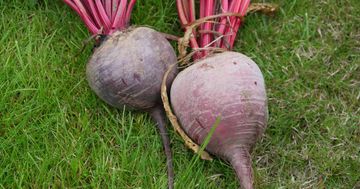Beetroot


Introduction
Beetroot is very easy to grow, making it an ideal crop for a novice gardener or for children.
Beetroot is delicious eaten hot, either boiled, or even better roasted (the tip is to leave the skin on and not to cut the flesh before cooking to keep all the flavours wrapped up inside).
Planting
- Planting depth: 2 cm and covered with fine soil
- Planting spacing: 12 cm between plants (thin after sowing) and 30 cm between rows
Harvesting
- Leave on the plot and eat as required (mature beetroot can withstand frost)
- Alternatively, store overwinter in a box of dry soil or sand
(inside)
(outside)
(fresh)
(stored)



 = freeze,
= freeze,  = store
= store
Varieties
Nearly all beetroots sold in shops are deep purple, but this does not represent the colourful range of beetroot varieties available. Growing your own beetroot gives the opportunity to enjoy a much wider range of varieties, including white, orange, and pink flesh bulbs. Lighter coloured beetroots have the added advantage of a reduced risk of staining your clothes with beetroot juice.
Aside from colour, beetroots have different growing and eating characteristics. If you have sandy soil, look for varieties that are ‘bolt hardy’. This means they are more tolerant of dry conditions and less likely to run to flower before harvest. Some varieties are hardy, and can be left on the plot for longer in autumn and picked when required. This saves the effort, and space, of storing them.
When eating beetroot, you may like to grow varieties that have sweeter stems and leaves, ideal for adding interest to salads (young beetroot leaves will be less chewy). Some varieties have flesh that can be eaten raw by grating into salads, whilst others are best cooked or pickled. One of my favourite ways of eating beetroot is roasted in the oven.
The easy way for a gardener to organise their growing and discover gardening ideas.
Growing
The plants suffer from very few pests and diseases, and are often left alone by birds thereby avoiding the need of a net. Beetroot will grow and taste at their best if the soil is kept moist, and should be eaten before they grow too large which can give them a woody flavour.
All varieties are sown at the same time of year, starting in the spring when the weather begins to warm up. Sowing a few seeds every fortnight will provide a successional harvest through the summer and autumn. I place my seeds about 2 to 3 centimetres apart in a shallow trench that I have previously watered, and loosely cover with soil.
It is possible to see the size of the growing beetroots above ground level by gently easing away the top earth. I have found the best size for flavour is to pick the bulbs when they are between a ping pong ball and a tennis ball in size.
